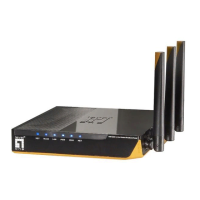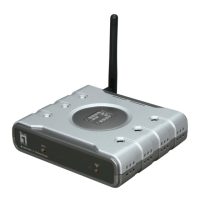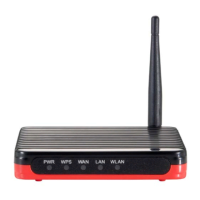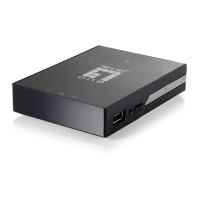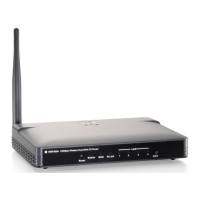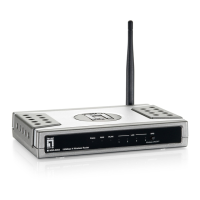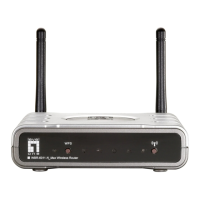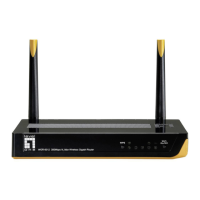Do you have a question about the LevelOne WBR-6601 and is the answer not in the manual?
Overview of the router's advanced features and capabilities for sophisticated functions.
Details on shared internet access, built-in ADSL modem, and connection support.
Explains ALGs, Dynamic DNS, URL Filter, Access Control, Firewall, Scheduling, Logs, Port Trigger, Port Forwarding, QoS, VPN Pass through.
Covers IEEE802.11g compliance, 11n station support, WEP, WPA-PSK, WPA2-PSK, and 802.1x security.
Details the 4-port switching hub and DHCP server support.
Covers Easy Setup, Configuration File Upload/Download, Remote Management, and Network Diagnostics.
Discusses Password protection, Wireless LAN Security, NAT Protection, Firewall, and DoS attack protection.
Explains the Power, LAN, WLAN, ADSL, and Internet LEDs on the front panel.
Lists necessary items like network cables, TCP/IP protocol, ISP account, and DSL connection.
Step-by-step guide for installing the Wireless ADSL Router.
Outlines the chapter's scope: Internet Access, LAN config, Wireless setup, password assignment.
Describes the main menu layout and navigation options.
Configuration of IP Address, Subnet Mask, and DHCP Server settings.
Covers Region, Multi SSID, SSID 1/2, Broadcast SSID, Isolation, Security, and Options.
Introduces Disabled, WEP, WPA-PSK, WPA2-PSK, Mixed, and 802.1x security.
Lists designated trusted stations and detected stations, with options to manage them.
Allows setting or changing the router's login password.
Selects between Router and Modem (Bridge) modes for the device.
Details PC configuration for Internet access, including TCP/IP settings.
Configuration steps for Windows PCs to access the internet.
Configuration for Internet access in Windows 9x/ME/2000.
Configuration for Internet access in Windows XP.
Specific setup for AOL software to use TCP/IP network access.
Configuration steps for Macintosh clients.
Configuration steps for Linux clients.
General configuration guidance for other Unix systems.
Ensures Mode, SSID, and Security settings match the router.
Steps to connect to a wireless network in Windows XP.
Automatic operation after configuration, with notes on additional settings.
View the router's operational status, including ADSL, Internet, LAN, and Wireless details.
Displays status for PPPoE/PPPoA connections, including login, IP, and link status.
Dynamic IP connection details, including IP, mask, gateway, DHCP server, and lease info.
Fixed IP connection details, including IP, mask, and default gateway.
Lists advanced features: Internet, DMZ, URL filter, Access Control, Dynamic DNS, Options, Schedule, Port Trigger, Port Forward, QoS.
Access to DMZ and URL Filter features.
Restricts internet access levels for PCs on the LAN by blocking services.
Explains how DDNS allows connecting via URL to a dynamic IP address.
Configuration for DDNS service provider, host name, user name, and password.
Settings for Internet (Ping, MTU Size) and UPnP.
Configures schedules for Firewall Rules and URL filter.
Defines applications as 'Port Triggers' to allow non-standard connections.
Makes LAN servers accessible by forwarding specific ports.
Makes LAN servers accessible by forwarding a range of ports.
Prioritizes network traffic for better throughput and reduced delay.
Explains settings for advanced users: PC Database, Config File, Logs, Diagnostics, Remote Admin, Routing, Firmware Upgrade.
Lists connected PCs and allows manual entry of fixed IP devices.
Advanced options for managing PC database entries, including IP and MAC address settings.
Backup, restore, or reset the router's configuration.
Displays router activity logs, with options to refresh, clear, or email logs.
Configures email notifications for logs and alerts.
Performs Ping and DNS Lookups to troubleshoot network issues.
Enables and configures remote management of the router via the Internet.
Accesses the routing table configuration.
Interface for uploading new firmware to update the router's software.
Explains the two modes: Router and Modem (Bridge).
Selects between Router and Modem (Bridge) modes for the device.
Displays status information specific to bridge (modem) mode.
Covers common problems and their solutions.
Troubleshooting for issues like inability to connect to the router.
Steps to resolve issues where a PC cannot find the wireless access point.
Explains Ad-hoc and Infrastructure modes.
Information on Basic Service Sets and Extended Service Sets.
Technical specifications for the WBR-6601 model.
Specifications related to wireless standards, frequency, and power.
FCC compliance information and user guidance.
Overview of the router's advanced features and capabilities for sophisticated functions.
Details on shared internet access, built-in ADSL modem, and connection support.
Explains ALGs, Dynamic DNS, URL Filter, Access Control, Firewall, Scheduling, Logs, Port Trigger, Port Forwarding, QoS, VPN Pass through.
Covers IEEE802.11g compliance, 11n station support, WEP, WPA-PSK, WPA2-PSK, and 802.1x security.
Details the 4-port switching hub and DHCP server support.
Covers Easy Setup, Configuration File Upload/Download, Remote Management, and Network Diagnostics.
Discusses Password protection, Wireless LAN Security, NAT Protection, Firewall, and DoS attack protection.
Explains the Power, LAN, WLAN, ADSL, and Internet LEDs on the front panel.
Lists necessary items like network cables, TCP/IP protocol, ISP account, and DSL connection.
Step-by-step guide for installing the Wireless ADSL Router.
Outlines the chapter's scope: Internet Access, LAN config, Wireless setup, password assignment.
Describes the main menu layout and navigation options.
Configuration of IP Address, Subnet Mask, and DHCP Server settings.
Covers Region, Multi SSID, SSID 1/2, Broadcast SSID, Isolation, Security, and Options.
Introduces Disabled, WEP, WPA-PSK, WPA2-PSK, Mixed, and 802.1x security.
Lists designated trusted stations and detected stations, with options to manage them.
Allows setting or changing the router's login password.
Selects between Router and Modem (Bridge) modes for the device.
Details PC configuration for Internet access, including TCP/IP settings.
Configuration steps for Windows PCs to access the internet.
Configuration for Internet access in Windows 9x/ME/2000.
Configuration for Internet access in Windows XP.
Specific setup for AOL software to use TCP/IP network access.
Configuration steps for Macintosh clients.
Configuration steps for Linux clients.
General configuration guidance for other Unix systems.
Ensures Mode, SSID, and Security settings match the router.
Steps to connect to a wireless network in Windows XP.
Automatic operation after configuration, with notes on additional settings.
View the router's operational status, including ADSL, Internet, LAN, and Wireless details.
Displays status for PPPoE/PPPoA connections, including login, IP, and link status.
Dynamic IP connection details, including IP, mask, gateway, DHCP server, and lease info.
Fixed IP connection details, including IP, mask, and default gateway.
Lists advanced features: Internet, DMZ, URL filter, Access Control, Dynamic DNS, Options, Schedule, Port Trigger, Port Forward, QoS.
Access to DMZ and URL Filter features.
Restricts internet access levels for PCs on the LAN by blocking services.
Explains how DDNS allows connecting via URL to a dynamic IP address.
Configuration for DDNS service provider, host name, user name, and password.
Settings for Internet (Ping, MTU Size) and UPnP.
Configures schedules for Firewall Rules and URL filter.
Defines applications as 'Port Triggers' to allow non-standard connections.
Makes LAN servers accessible by forwarding specific ports.
Makes LAN servers accessible by forwarding a range of ports.
Prioritizes network traffic for better throughput and reduced delay.
Explains settings for advanced users: PC Database, Config File, Logs, Diagnostics, Remote Admin, Routing, Firmware Upgrade.
Lists connected PCs and allows manual entry of fixed IP devices.
Advanced options for managing PC database entries, including IP and MAC address settings.
Backup, restore, or reset the router's configuration.
Displays router activity logs, with options to refresh, clear, or email logs.
Configures email notifications for logs and alerts.
Performs Ping and DNS Lookups to troubleshoot network issues.
Enables and configures remote management of the router via the Internet.
Accesses the routing table configuration.
Interface for uploading new firmware to update the router's software.
Explains the two modes: Router and Modem (Bridge).
Selects between Router and Modem (Bridge) modes for the device.
Displays status information specific to bridge (modem) mode.
Covers common problems and their solutions.
Troubleshooting for issues like inability to connect to the router.
Steps to resolve issues where a PC cannot find the wireless access point.
Explains Ad-hoc and Infrastructure modes.
Information on Basic Service Sets and Extended Service Sets.
Technical specifications for the WBR-6601 model.
Specifications related to wireless standards, frequency, and power.
FCC compliance information and user guidance.
| Frequency Band | 2.4 GHz |
|---|---|
| Wireless Speed | Up to 300Mbps |
| Ports | 4 x 10/100Mbps LAN, 1 x 10/100Mbps WAN |
| Security | WEP, WPA, WPA2 |
| Wireless Standard | 802.11b/g |
| Firewall | SPI Firewall |
| VPN Support | PPTP, L2TP, IPSec |
| Antenna | 2 x External Antennas |
